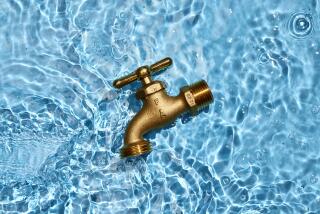Gray water: from the washer to the garden
I was never more excited to do laundry, and it wasn’t because my son and I were running out of clean underwear. I had just installed a system to divert gray water from my washing machine to my xeriscaped frontyard, and I was anxious about whether the $312 and two days I’d spent installing it would pay off.
Considering all the money and political squabbling that goes into getting water to this desert metropolis, it seems silly not to recycle water once it’s here. Especially now. Gov. Arnold Schwarzenegger and L.A. Mayor Antonio Villaraigosa are telling us to conserve, which I do. I was still using 253 gallons at my home each day, according to my latest Department of Water and Power bill. I just wanted to use less, and recycling my gray water was one way to do it.
Gray water is the wastewater generated from sinks, showers, bathtubs and laundry machines. All of it could be used to irrigate plants but, instead, is drained to the sewer in Los Angeles County, where it’s treated and, for the most part, sent into the Pacific.
In L.A., about 40% of the water used at home is for outdoor irrigation, according to the DWP. The rest is used indoors. In theory, that meant I could get all the water for my landscape from what I was already using inside. I also would be saving money and doing my minuscule part to save the state.
But, like so many other things in life, translating desire into action is often problematic, as I learned while installing a gray water system at my 90-year-old bungalow in Highland Park. Technically, it’s possible, but only if the system can clear the exceptionally tall technological, financial and bureaucratic hurdles set out in Appendix G of the California plumbing code, which went into effect in 1992 at the tail end of a five-year drought.
The big issue for the state is public health. Releasing untreated water into a landscape may spread bacteria and make humans and animals sick. That’s why the code requires gray water systems to be installed underground.
Although none of the gray water advocates or L.A. County health officials I spoke with for this column are aware of any incidents of gray water-induced sickness, health concerns are the main reason why so few permitted gray water systems exist in the state -- and why most people install them without permits, as I did.
The daunting technological legalese of the plumbing code sent me scouring the Internet for other options, which I found through the Santa Barbara firm Oasis Design and a group called the Greywater Guerrillas in Oakland. Pretty much everything I had ever wanted to know about gray water -- and then some -- was available at www.oasisdesign.net, where I spent the better part of an afternoon learning the basics and purchasing two books.
The photocopied-and-stapled “Builder’s Greywater Guide” reiterated many of the same technical and legal issues that had been outlined on the Oasis site, and the glossy and perfect-bound “Create an Oasis With Greywater” gave me more detailed information on systems to consider.
Gray water can be harvested from four principal places in the home. The most desirable is the washing machine, which can generate 10 to 50 gallons a load and have the added benefit of a built-in pump that helps push the water through the plumbing and into the garden.
Showers generate at least 2.5 gallons of water a minute, even from low-flow shower heads, and baths typically use 30 to 40 gallons a soak. They generate a lot of water, but they may also require an additional pump and surge tank, which means more money, electricity and maintenance. Kitchen sinks don’t generate much wastewater, and the water they do yield is full of potentially problematic food debris requiring more complex systems.
Reading the books, I made two decisions: I was installing a gray water system, and I was doing it with my washing machine. By my estimate, it would give me 90 gallons a week.
What the books didn’t provide were enough specifics for me. I’m only a moderately handy person. I need to see and touch and feel something to truly understand it. I needed a workshop.
That’s where the Greywater Guerrillas came in. The self-described group of educators, designers, builders and artists who teach and empower people to “build sustainable water culture and infrastructure” holds semimonthly workshops, mostly in the Bay Area, for wannabe do-it-yourselfers.
I reserved a spot and headed up in August, when the guerrillas planned to take over a Berkeley couple’s house for a day and send their washing-machine water out to their fruit trees and ornamentals.
Over five hours, I re-learned much of what I already knew from the Oasis website and books. I also got to cut and glue pieces of PVC, snip garden hose, dig mulch basins and otherwise help to install the system I hoped to put into action at my house.
The participatory aspect of the workshop was invaluable, but even better was a shopping list, which included the names of each part I’d need, complete with model numbers. All but four items could be purchased from the California-based irrigation company DripWorks ( www.dripworksusa.com). I placed my order online, and a box showed up on my doorstep two days later.
The 1-inch-diameter PVC plumbing pipe I needed to re-route the gray water from my washing machine was easily procured from a plumbing supply shop. But I did have trouble finding the three-way plumbing valve I needed to switch my dirty laundry water between my yard (where I planned to send it in dry months) and the sewer (where I’d send it when it was raining or when I was running a load with bleach); I had to buy the valve from the Greywater Guerrillas.
The 100 feet of 1-inch-diameter HDPE irrigation tubing I needed to carry gray water into my yard was impossible to find. I called three irrigation suppliers in L.A., and none had it, so I gave up and bought more expensive and less environmentally sound PVC spa hose from the Home Depot.
Then there were the U-shaped garden stakes to hold the curly spa hose in place. After visiting four nurseries, I ended up crafting my own with ceiling wire and a wire cutter.
Supplies in hand, I was ready to start construction.
Or so I thought. As soon as my washing machine was pulled away from its spot inside a closet and I got an up-close look at the maze of tubes and hookups running to the wall, my mind went blank. My hands-on experience in Berkeley, the notes I’d taken and everything else I thought I had learned flew out the window.
If you are not especially handy, I suggest playing plumber’s apprentice to a friend who’s better schooled in the ways of ratcheting blades and PVC glue. That’s what I did for the first day of the install, which focused on rerouting the plumbing. By comparison, the second day was easy -- running the spa and feeder hoses through the landscape, staking them down, mulching.
After seven trips to the plumbing shop and six trips to the Home Depot, the system was ready to roll. I filled up my Whirlpool Thin Twin with my kindergartner’s filthy boywear and Ecos detergent, and I waited for the spin cycle as I never had before.
When the water poured into the garden, my flax, osmanthus and agapanthus were happy. Myself? I was so thrilled I danced.
susan.carpenter@latimes.com
More to Read
Sign up for The Wild
We’ll help you find the best places to hike, bike and run, as well as the perfect silent spots for meditation and yoga.
You may occasionally receive promotional content from the Los Angeles Times.










